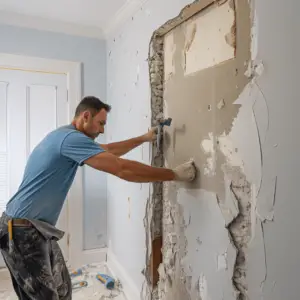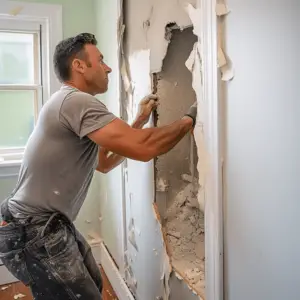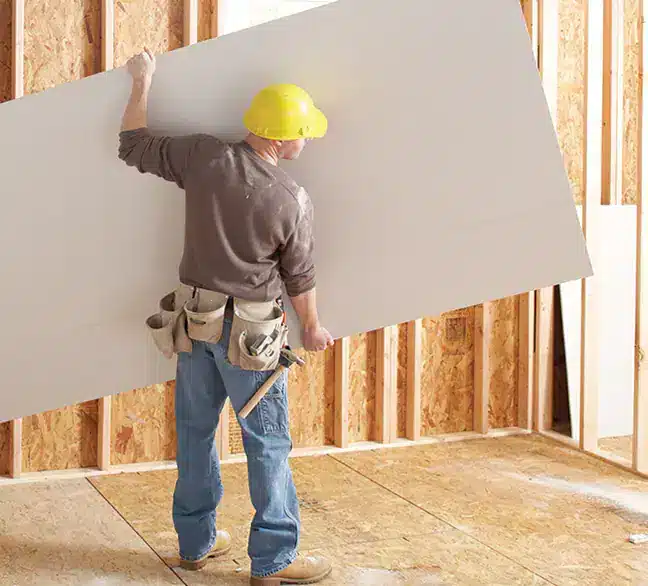Drywall Repair, If you find that the drywall job in your home is not up to par, there are steps you can take to fix it.
Drywall is a common material used for walls and ceilings. It’s made of gypsum plaster sandwiched between two sheets of special paper.
Drywall is easy to work with but can be tricky to install. If you’re having trouble with your drywall installation, don’t despair. You can fix it. Before you start, though, assess the situation. Is it just a small repair, or do you have a big problem?
Table of Contents
How Bad is It?

Before attempting any repair or replacement, it’s important to assess how bad the problem is, so you know how much time and money it will take to fix it. A minor repair may be as simple as sanding down and repainting an area with no cracks or holes. However, if there are gaping holes in the wall, you’ll need more than just sanding and painting — you’ll probably need new drywall installed.
It’s not always necessary to hire a professional for repair jobs like this — especially if all that needs to be done is repairing holes and cracks. There are several simple methods you can use at home to fix these common problems.
To fix a bad drywall job, you’ll need:
- Drywall mud (also called joint compound)
- Sandpaper
- Drywall tape and corner bead (if necessary)
- Putty knife
- Roller
- A utility knife
- Paint primer and paint (if needed)
How to Fix a Bad Drywall Job
Prep The Room
You need to prep the room so that you can get started with your drywall repair project. It will need to remove any furniture or other items from the wall in question. You will also need to cover up any electrical outlets, switches, and lights that are located on the wall.
Repairing Holes in Drywall
Drywall holes have several causes. Some remodelers accidently knock holes in their walls, while others use hammers or screwdrivers without safeguards.
Spackle or latex caulking can patch gaps and holes to flush with the wall. Use a putty knife or taping knife to apply the compound, then smooth with a finger or towel.
To fill deep holes, pour another coat of mud over the first. After that, use your finger or a knife to smooth any rough edges so they’re flat with the wall.
To avoid cracks along the hole’s edges, let it dry fully before sanding off excess spackle and priming and painting.
How to Fix Drywall Corners
Drywall corners are usually created using a corner bead, which is a metal or plastic strip that runs along the outside edge of the wall. The corner bead protects the wall from getting damaged during installation or while painting.
You can repair a drywall corner by applying another coat of mud, thinning it, so it covers the joint and makes it disappear.
You can also install a corner guard over the damaged spot.
Fixing Uneven Drywall
Drywall Repair there are sections of drywall that are higher than others, you can use a utility knife to cut away any excess material from around the area. Then use a putty knife to fill in the gap with joint compound (the stuff you used for patching). After it dries, sand it smooth with fine sandpaper until it’s flush with the wall.
Sand Away the Problem Areas
After filling any holes and gaps, carefully sand the area to remove any rough places from the compound. If you’re only correcting a few small locations, you can skip sanding, but if you have larger regions to fix, you should sand everything down.
Check For Gaps Between Joints

If you look closely, you can frequently detect little holes or depressions in the joint compound (the material used to heal fissures). If so, use a joint knife or utility knife to scrape off the paper covering the joints, then a putty knife or other flat blade to fill the gaps.
Check For Missing or Faded Tape Lines
The most common reason for this is that the painter didn’t use enough paint or primer before applying the tape. Make sure you’re using enough paint to cover all of your surface areas before applying tape — and make sure it’s dry before removing it!
Check for Mold
Mold can grow in wall cavities when moisture gets trapped behind drywall — especially if you live in an area with high humidity or frequent rainstorms. If you see signs of mold on your walls, contact a licensed contractor for advice on removing it safely before proceeding with repairs.
Conclusion
Drywall is a cheap option to update your home. Drywall is straightforward to install and produces significant results quickly. Very durable and long-lasting. Most things in life have a catch: drywall isn’t flawless. A decent drywall work can last for years without wear and tear. If you have terrible drywall, you may have difficulties sleeping at night knowing that everyone who enters your home laughs at you.
If you know how, fixing damaged drywall is easy. This post has ways to fix those unpleasant spots in your home and restore its charm!


